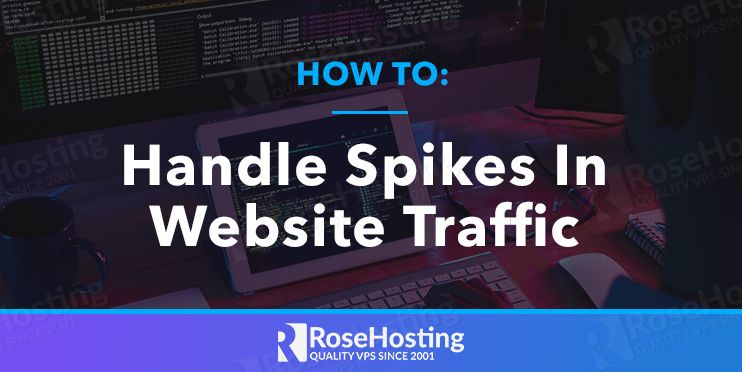
It’s exciting to see an increase in visitors to your website. More traffic usually means more cash – or, at the very least, more readers. However, traffic growth isn’t necessarily the product of organic growth. What if you have to deal with a sudden surge in website traffic?
What Causes Sudden Website Traffic Spikes
Many factors can contribute to increased website traffic. Unfortunately, not all of them are beneficial. A bot assault, for example, may result in metrics indicating a substantial increase in visitor traffic.
On the bright side, it could also be the result of your current marketing activities. To deal with traffic spokes appropriately, you must first understand what is causing them.
Sudden traffic surges can occur for a variety of reasons, including:
- Mentions of a website or a brand on social media
- Off-site marketing efforts
- Links on major websites with a lot of traffic
- Attacks by bots

How to Handle Website Traffic Spikes
The easiest method to deal with a traffic spike is to have tools in place that can lessen it before it occurs. Spikes can occur unexpectedly and for no apparent cause; attempting to correct them at the last minute is usually ineffective. Here are some practical suggestions for preventing your site from crashing due to traffic spikes.
Use a Load Balancing Solution
Strain balancing distributes the load on your server across various platforms. This is a widely available service. While typically utilized by websites with significant traffic counts, a load balancing system can also protect against potential traffic surges. A load balancer is used as a proxy for your server. When traffic peaks, the load balancer leverages multiple servers to balance out the increasing volume of HTTP requests.
Opt for Faster Hosting Storage
Storage is a significant service bottleneck in practically all computing devices. This was owing to the mechanical nature of storage systems in the past. Many hosting companies are now offering SSD storage, which is significantly faster than standard hard discs. Consider switching to a hosting package that includes SSD drives if you don’t currently have one. SSD’s faster speeds may be advantageous in servicing a more significant number of website visitors. You can choose RoseHosting’s Fully Managed Cloud Hosting service for affordable NVMe hosting. Check out the differences between NVMe and SSD.
Make Use of a Content Distribution Network
One of the most effective ways to improve site performance is to use Content Distribution Networks (CDNs). They work by catching some elements of your site on worldwide server networks, allowing visitors to access resources faster. Many CDNs have the inbuilt ability to help you resist bot attacks, which is a crucial feature. Cloudflare, for example, provides a “Bot Fight Mode” that you may activate to deal with a bot-induced traffic flood. You can also create firewall rules to assist you filter traffic. When used correctly, you may stop non-genuine visitor traffic even before it reaches your website, thereby saving time and money.
Implement Caching
Caching is one of the most effective strategies to improve the performance of a website. It works by saving completed requests in memory (or another kind of fast storage) so that the page can be delivered to others rather than having to be produced each time again. On many websites, this type of performance enhancement can drastically reduce resource consumption. As a result, you’ll be able to handle far more website traffic than you would if you didn’t have to cache.

Deploy Performance Monitoring Services
We’re all human, and we can’t possibly keep an eye on our websites 24 hours a day, seven days a week. Even committed IT teams may not be able to continuously monitor a website for issues. Thankfully, there are a lot of website performance monitoring tools available to help us with this. Some plugins are available for WordPress site owners that can do this function. If not, you can use a website performance monitor like Freshping or Solarwind’s. These tools might send you notifications if they see any anomalies on your site.
Optimize Media Content
Media material, such as photographs and video, sometimes takes up the majority of a web page on many websites. The more resources and time it takes to download your media files onto the website, the longer it takes for the page to load.
Optimize your photos to make your website load faster. This is usually accomplished by decreasing the content’s quality marginally. Converting them to newer, web-optimized forms like WebP, on the other hand, is helpful.
Integrate a Dedicated Security Service
Although we discussed Cloudflare’s capacity to manage bots before, not all CDNs do. Consider working with a dedicated protection service provider instead of an all-in-one solution if you don’t want to employ an all-in-one solution. There are a lot of such service providers on the market. They can help to prevent possible overloads created by bad bots that use their own resources rather than those provided by your hosting platform.
Plan Your Marketing Campaigns
If you know that particular marketing initiatives will result in traffic spikes, make sure they’re well-planned. When compared to broad efforts during peak seasons, executing highly focused campaigns can help limit spikes at any particular time.
This is something that can be planned remotely, but it will require a significant degree of collaboration between your site’s technical and marketing teams. If your team is dispersed, a communication platform like Slack might help you better manage and plan your timeline.
Carry Out Load Testing
Make sure you know what your site can handle before traffic spikes cause it to crash. There are a variety of ways to do this, ranging from local applications to internet services, but load testing is by far the most effective technique of predicting traffic-related issues. It can not only assist you with resource provisioning but can also predict when you will need to execute emergency measures in the event of a spike.
Final Thoughts
At some point in your website’s lifespan, traffic surges will occur. The more popular your website is, the more likely you are to come across one. Don’t wait until the last minute to freak out. Always be sure that, in addition to catastrophe mitigation, you have emergency plans in place for disaster recovery.
In the end, the best way to handle spikes in website traffic is to choose a trustworthy and reliable hosting provider that offers fast and affordable NVMe hosting, like our Managed Cloud Hosting. Our dedicated team of expert system admins will be there to guide you along the way and help you with any question you might have, 24/7, 365 days a year.